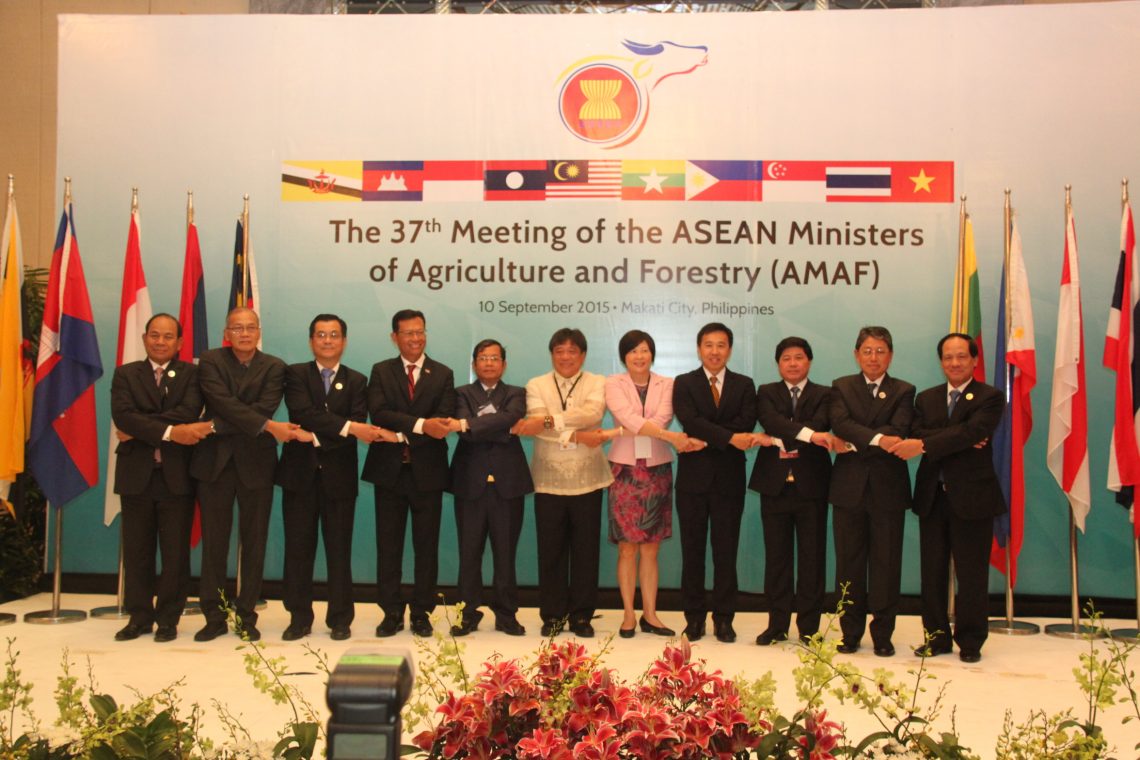1. We, the ASEAN Ministers of Agriculture and Forestry (AMAF), held our 37th Meeting on 10 September 2015 in Makati City, the Philippines, under the Chairmanship of H.E. Mr. Proceso J. Alcala, Secretary of the Department of Agriculture of the Philippines.
Moving Towards 2015 and Beyond
2. We were encouraged that ASEAN cooperation in food, agriculture and forestry significantly contributed to the successful realisation of the ASEAN Community 2015,with 90.9% of the measures related to food, agriculture and forestry under the Roadmap for an ASEAN Community 2015 have been implemented as of today. We are confident that the implementation of the remaining measures will be completed by December 2015.
3. Building upon the achievement of the ASEAN Community, we endorsed the Vision and Strategic Plan for ASEAN Cooperation in Food, Agriculture and Forestry 2016-2025 to chart out directions for ASEAN cooperation in these areas in supporting the realization of the ASEAN Community Vision 2025. Under this Strategic Plan, we envisioned “A competitive, inclusive, resilient and sustainable Food, Agriculture, and Forestry (FAF) sectors integrated with the global economy, based on a single market and production base contributing to food and nutrition security, and prosperity in the ASEAN Community”. This vision will be realised with comprehensive action programmes under seven (7) strategic thrusts, namely:
i. Enhance quantity and quality of production with sustainable, ‘green’ technologies, resource management systems, and minimise pre- and post-harvest losses and waste;
ii. Enhance trade facilitation, economic integration and market access;
iii. Ensure food security, food safety, better nutrition and equitable distribution;
iv. Increase resilience to climate change, natural disasters and other shocks;
v. Assist resource constrained small producers and SMEs to improve productivity, technology and product quality, to meet global market standards and increase competitiveness;
vi. Strengthen ASEAN joint approaches on international and regional issues affecting the FAF sector;
vii. Promote sustainable forest management.
Download The Full Statement here.
- ABOUT ASEANThe Association of Southeast Asian Nations, or ASEAN, was established on 8 August 1967 in Bangkok, Thailand, with the signing of the ASEAN Declaration (Bangkok Declaration) by the Founding Fathers of ASEAN: Indonesia, Malaysia, Philippines, Singapore and Thailand. Brunei Darussalam joined ASEAN on 7 January 1984, followed by Viet Nam on 28 July 1995, Lao PDR and Myanmar on 23 July 1997, and Cambodia on 30 April 1999, making up what is today the ten Member States of ASEAN.Menu
- WHAT WE DO
ASEAN organs always strive to achieve ASEAN’s goals and objectives, the Secretary-General of ASEAN and the ASEAN Secretariat shall be functioned as coordinating Secretariat to help facilitate effective decision-making withing and amongst ASEAN bodies. In addition, each Member State shall appoint a Permanent Representative to liaise with Secretary-General of ASEAN and the ASEAN Secretariat
Menu - WHO WE WORK WITH
ASEAN shall develop friendly relations and mutually beneficial dialogues, cooperation and partnerships with countries and sub-regional, regional and international organisations and institutions. This includes external partners, ASEAN entities, human rights bodies, non-ASEAN Member States Ambassadors to ASEAN, ASEAN committees in third countries and international organisations, as well as international / regional organisations.
Menu - OUR COMMUNITIES
The rodmap for an ASEAN Community (2009-2015) was declared by the leaders in 2009. The ASEAN Community, anchored on three community pillars: Political-Security Community, Economic Community, Socio-Cultural Community was launched in 2015. The ASEAN 2025: Forging Ahead Together was introduced in 2015 as a Post-2015 Vision. It comprises the ASEAN Community Vision 2025, the ASEAN Political-Security Community Blueprint 2025, the ASEAN Economic Community Blueprint 2025 and the ASEAN Socio-Cultural Community Blueprint 2025
Menu - SITEMAP





